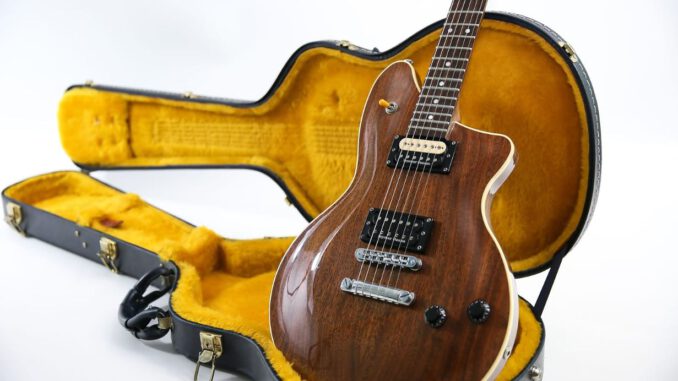
For all the advancements made in guitar design, one thing has remained essentially the same: try as you might, you can never get the damned things in perfect tune. If an open E chord sounds great, chances are a barred A will sound decidedly less so. Blame it on Pythagoras. Back around 500 B.C., the Greek philosopher and mathematician developed a formula, albeit an imperfect one, for tuning stringed instruments. His formula was popular—so popular, in fact, that it’s still in use today. Which is why your guitar relies on a design that’s about 2,500 years old.
Time for a change? One man thinks so. That man Buzz Feiten, an accomplished studio musician and a veteran of such touring acts as Bette Midler and Stevie Wonder. Buzz was plagued by a problem common to many players: his guitar never sounded quite right no matter how many times tuned it or tweaked the intonation. After watching piano tuners adjusting the pianos used on stage, he became envious of the instrument’s ability to sound perfectly in tune regardless of the key, position or chord voicings used by the player. He became so fed up with the sour notes produced by his “tuned” guitar that he re-evaluated the entire tuning system of the common guitar.
The result was the Feiten Tuning System, his revolutionary tuning system that offers a genuine improvement over the one used by guitarists for centuries. Feiten’s work took years, but the result is an instrument that sounds in tune across the fretboard with even the most complex of chords. His system was a significant breakthrough for the old six-string; still, many players remained skeptical. That is, until players like Vai and Van Halen started using the F-word.

Feiten’s system can be applied to any thing from acoustic to electric guitars to basses and classical guitars, and with only a few minor alterations. Unfortunately, implementing the system has been somewhat more complex: luthiers need training and a sound knowledge of the Feiten system to make the adjustments successfully. Since only a handful of people know how to perform the operation, it was unlikely you could enjoy the benefits. Unless, of course, your surname was Satriani.
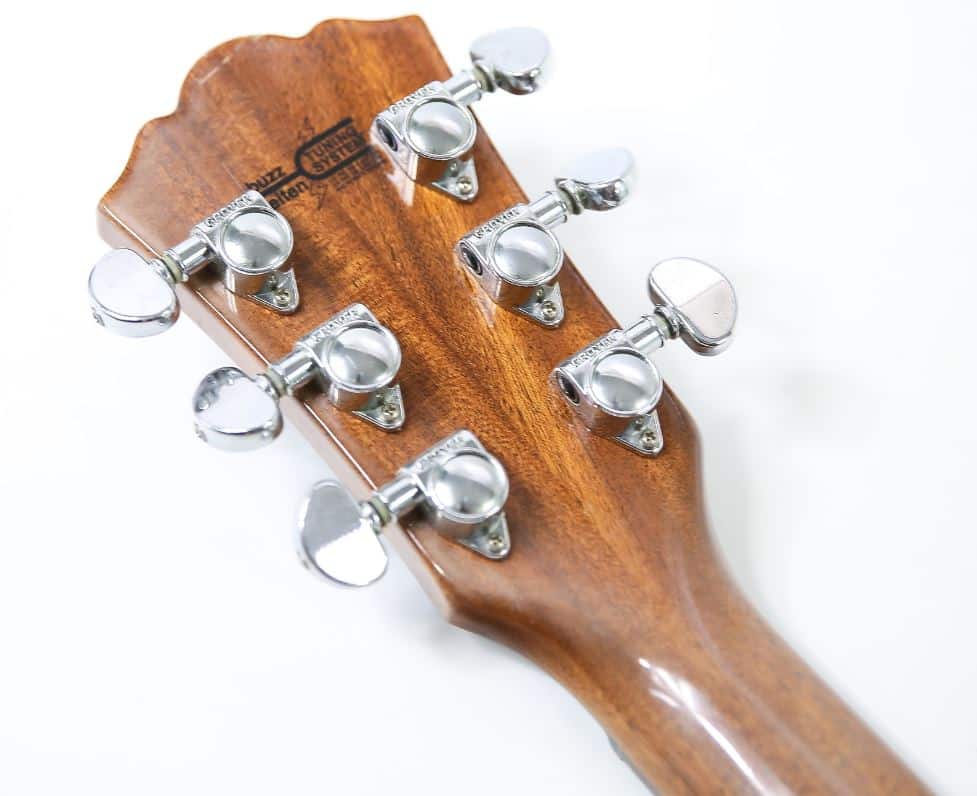 Now it’s the common man’s turn, and this month’s Big Guys to the Rescue Award goes to Washburn, whose unshakable belief in the system has led them to build every single one of their U.S. guitars to Feiten specs. One of the chief proponents of Feiten’s system was Larry English, a gifted luthier from Washburn’s Chicago custom shop. English was introduced to the system the January 1997 NAMM show and has been a fanatic Feiten convert ever since.
Now it’s the common man’s turn, and this month’s Big Guys to the Rescue Award goes to Washburn, whose unshakable belief in the system has led them to build every single one of their U.S. guitars to Feiten specs. One of the chief proponents of Feiten’s system was Larry English, a gifted luthier from Washburn’s Chicago custom shop. English was introduced to the system the January 1997 NAMM show and has been a fanatic Feiten convert ever since.
“The result of the use of the system is that the fingerboard seems to be in tune throughout,” says English. “No matter what chord structure you’re using, all of the notes in that structure sound pleasant. You can play a barred E, then a barred A, and all of the notes will sound right together. You can play some of those triads that normally have problems without having to play around sour notes.” And, perhaps not surprisingly, Feiten’s system at last makes it possible for guitars and keyboards to stay in tune with each other across any number of key changes. “Those are some very practical advantages and significant changes,” says English, and who could disagree? Feiten’s system allows you to spend less time tuning and more time playing. And because it is a much better method of intonation, it’s more forgiving than the standard system if your strings are slightly out of tune. Or as English neatly sums it up: “This is really big stuff.”
Washburn apparently agrees. Once the company discovered Feiten’s system, they took it very seriously, very quickly: Washburn signed the licensing agreement in January of ’98 after English had devoted one year to researching the system, building prototyepes and having professionals play them.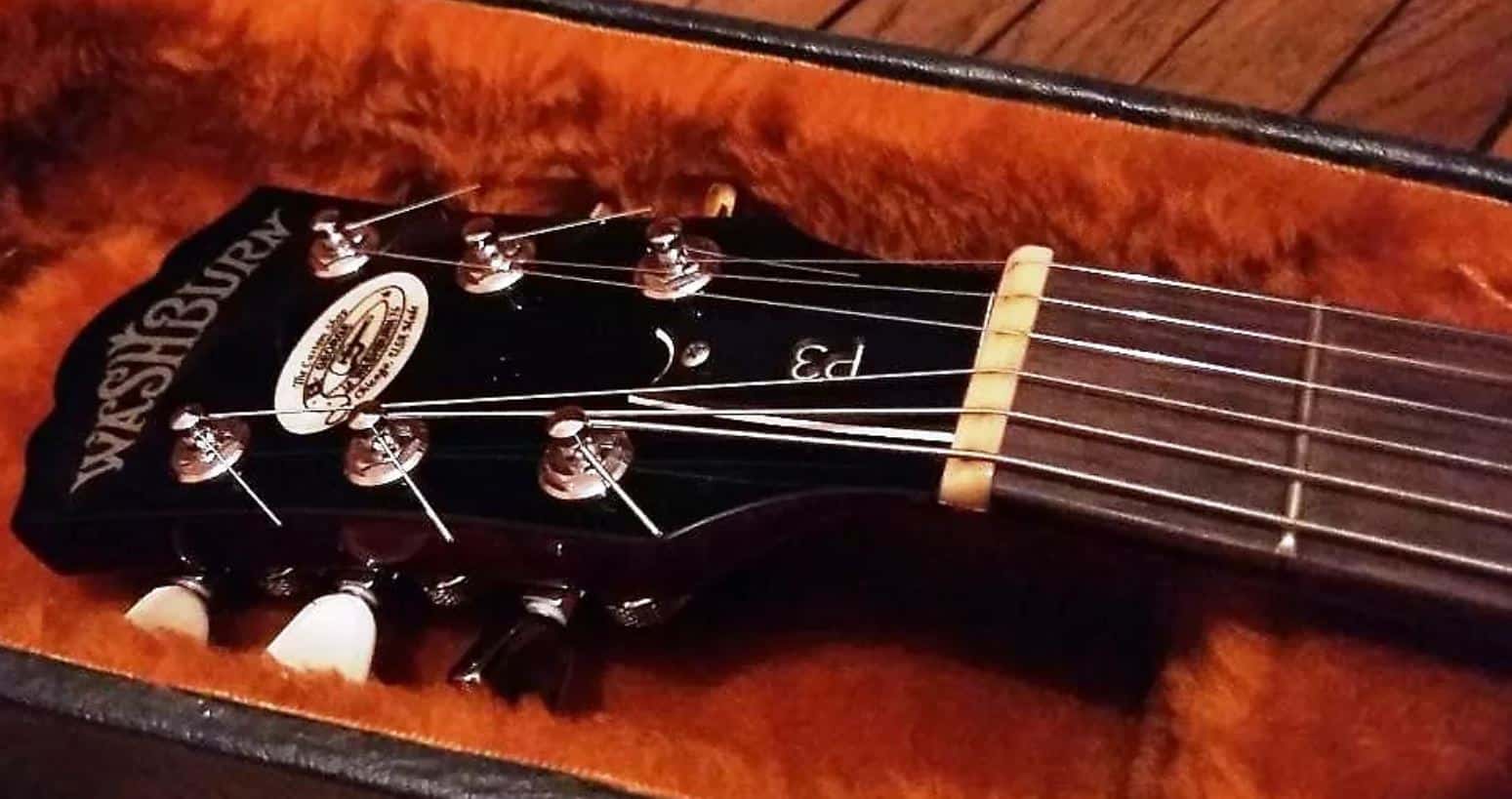
English then tested his guitars by surveying retailers, sales people and consumers at 61 retail locations in eight geographic areas of the United States. Says English, “It was extensive, but the bottom line was that 77 percent of people surveyed believed that was a problem with intonation in guitars, in general. I believe it was about 89 percent of the people could hear the difference with the new guitars.” If Washburn had any doubts about Feiten’s system, the survey effectively eliminated them. “The number-one point was that people knew there was a problem, and it seemed ludicrous to me that guitar manufactures had hidden their heads in the sand,” says English. “I’ve been in the business for over 30 years, and the main complaint I heard in that time was very consistent: ‘My guitar is out of tune. It plays well, sounds fine down here, but it goes out of tune above the 12th fret. Can you fix it?’”
In fact, the problem is not unique to guitars; keyboards were similarly afflicted until they were cured through tempered tuning toward the end of the 1500s. Tempered tuning is a method by which pianos were made to sound more pleasant and tuneful. At one time pianos were equal tempered, which meant they were tuned in accordance with a rigid mathematical formula. As Larry points out, “Mathematically, Pythagoras was 100 percent correct. He nailed it!” Unfortunately, in the real world, differences in string gauge, tensions and pitch mean that the precise language of math doesn’t always sound very good. By tempering the tuning it was possible to make certain allowances, tweak out of the gremlins and produce a sweeter sound.
Guitars are still equal tempered, and it was Buzz’s turn to do the math. “The guitar, being a folk instrument all those years, wasn’t paid much attention,” explains English. “Bach, Hadyn and Mozart weren’t playing guitar! Now it’s finally caught up. The consumer is demanding that the guitar at lest be in tune with itself.”
To illustrate the enhanced performance of their system, Washburn sent us two of their U.S. custom shop guitars that incorporate Feiten’s specifications. The guitars themselves are the handsome “Princess” design that have been seen in the nimble hands of Nuno Bettencourt, among others. Borrowing heavily from traditional designs, both the P3 and DLX models have bound, carved top mahogany bodies with a glued-in mahogany neck. Each has 22 frets and two humbuckers, courtesy of Seymour Duncan.
The P3 is the less glitzy and more slimline of the duo, sort of a “junior” to the “custom” DLX. The original body shape is still arched on top, but the guitar has a stripped-down and rock-ready vibe, with an unbound neck, dot markers and master volume and tone controls. Washburn have opted for a customized look with the pickups by mixing a black unit in the bridge with a zebra Duncan at the neck, which adds to the workhorse look. The traditional flavor continues with a Tune-O-Matic style bridge, sealed tuners, all in chrome. The accurately machined body is pretty shallow, making the P3 svelte in the weight department.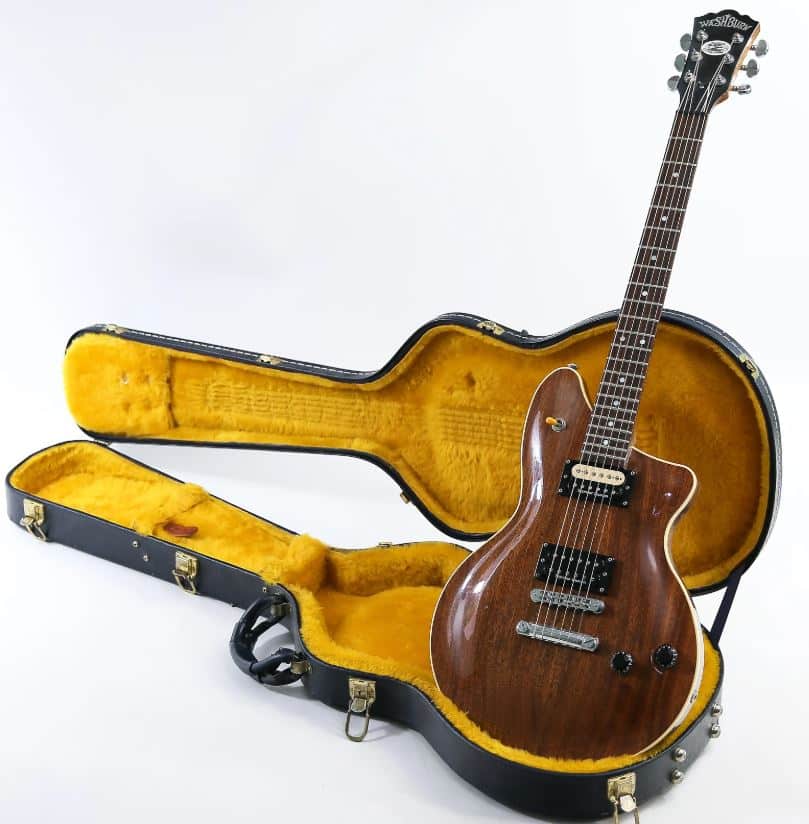
By comparison the DLX is a sumo, a real chunk of wood. The body is beefed out further with an exquisite, bookmatched flame maple top, and this sultry piece of lumber looks positively sexy wearing nothing but a slinky cherry ‘burst. The higher price tag reflected in some refined appointments, such as neck binding, novel teardrop inlays, fine tuners on the tailpiece, roller saddles and locking machineheads. These tuners are not the most aesthetically pleasing of the ilk but do a commendable job of stabilizing slippy strings. The twin Duncan humbuckers are treated to individual volume and tone controls, which offer more tonal variation over the P3 electronics.
Both guitars feature superb neck profiles, that on the P3 being comfortably full with a substantial, yet easygoing feel. The DLX seems to have a slightly more shallow neck, which is equally player friendly; both guitars are reminiscent of certain sought-after Gibson. Where Washburn scores big bonus points is on the neck heel, which has been heavily dressed back at an angle that makes those upper-register warbles an absolute breeze.
Plugged in, these puppies don’t disappoint either. The P3 has a great woody tone, with an exciting snarl when pushed. Both pickups are very dynamic and happily belt out a range on vintage jangles form clean to rocking. The DLX is an absolute monster, with sumo tone to match its girth. It does the Les Paul thing without breaking a sweat, from fat cleans to all-out, thump ‘n’ squeal metal. The neck pickup is sweet and vocal, and the bridge unit simply rocks. Buzz’s magic touch aside, both these guitars are worth a thorough check if rock is your bag.
Back to the plot and that enigmatic Feiten thingy. Visually there is not much to see, as the system only requires that the nut is moved neck-wards a few millimeters, the saddles are adjusted and the intonation is set according to Feiten’s procedure. In order to test the results, we pitted the two Washburns against a Les Paul that had a resent set-up and an old Charvel that has the best intonation of any guitar in my secret gearvault. All guitars had fresh strings and were tuned by tuning an E on each string, as suggested by Larry English, using a quality electronic tuner. The test amp was a Carvin BelAir 50-watt tube combo.
I have to admit that the earth didn’t move when I first tried the Feiten system guitars. Still, as I swapped between them and the test instruments, I found I was spending less time with my loyal favorites and more time with a Washburn in my hands. The inherent good tone of the P3 and DLX aside, there is something more musical in their sound. They simply sound more right.
Taking it to the next level, I dug out some old riffs that I’d abandoned because they sounded lousy. The riffs typically employed closely grouped chords in high positions, and either the two parts hadn’t sounded in tune (although technically they should have) or certain notes mushed or rang sour. On the test guitars they still sounded lumpy, but on the Washburns they sounded better. In fact, if you can squeeze your fingers into a barre at the 16th fret, the Washburns will still hold their tuning. The effect is subtle for normal playing, but it really does sound good, and the pleasant overall tone inspires you to play on.
Granted, the Feiten system is a much harder concept to sell than something like a pickup, and according to Larry English it took quite a bit persuading to convince the staff at Washburn that the idea was worth turning everything upside down for. However, the result is an invisible adjustment that really seems to improve the performance of the guitar and brings a subtle quality to the sound that no pickup could. Rumor has it that once you get intimate with the Feiten system, a standard guitar just won’t cut it anymore. I must admit that my old Number One started to sound a bit lifeless after a long weekend with the Washburn twins.
Washburn are applying this system to all of their U.S. guitars and to some of their import models as well. “It sounds great on an electric guitar, but it also sounds great on a bass. Stu Hamm said that his Fender signature basses used to be nine cents off at the first fret. With this system it’s nailed. It sounds phenomenal on acoustic guitars. Classic and steel-strung acoustics are also modified, but in those cases the bridge must be adjusted, or the saddle has to be molded differently and the slot modified. It is a different process for each type of instrument and the formulas used are also different,” says English. So no matter what style of guitar you play, if Buzz does it for you, Washburn has a guitar to match your needs.
The End Line
It’s easy to be suspicious of this invisible black magic that promises so much. Not being blessed with the ears of Eric Johnson, I wasn’t even sure I’d notice the difference. But there is one. It may not be as obvious an embellishment as a Floyd Rose or a death ‘bucker, but it effectively alters the sound of your guitar for the better. It may be subtle, but it will make those chords sound good, and make them sound good anywhere on the neck. Anything that makes my playing sound better gets some serious consideration. It also doesn’t hurt that it comes onboard such great guitars as the P3 and DLX “It’s just incredible,” says English. “It’s vastly improved our instruments. I’ve yet to meet an accomplished player that has not consistently been overwhelmed by it. I’ve seen people in tears.” He warns that your reaction may be a little less restrained.


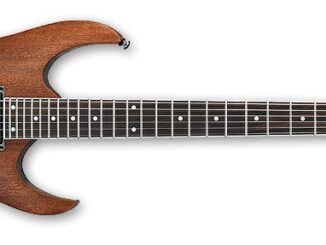

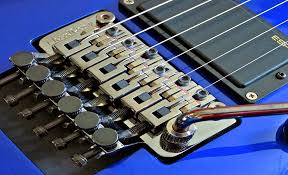
Be the first to comment